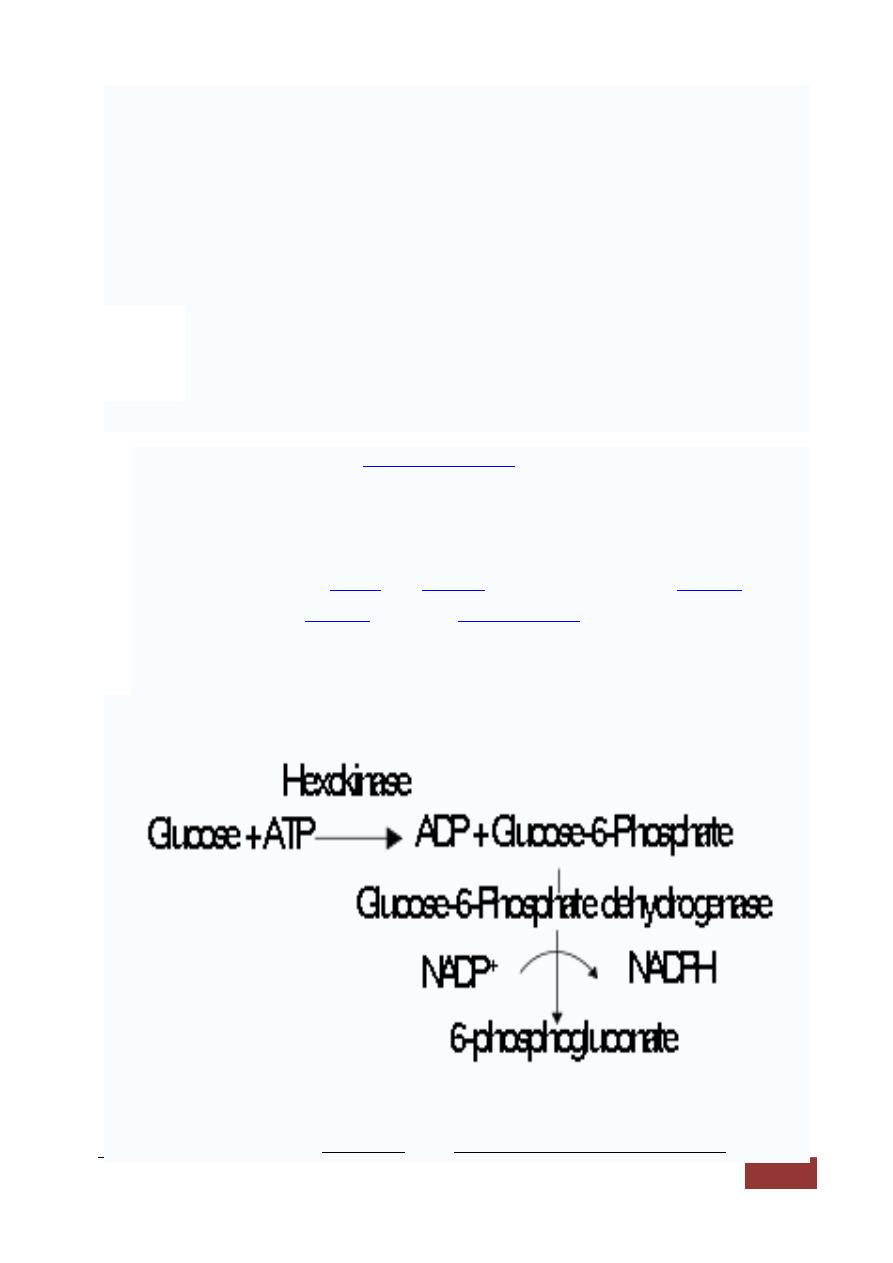
2012
Prof. Dr. H.D. El-Yassin
October 2012
[
ENZYMES ASSAY
]
[Type the abstract of the document here. The abstract is typically a short summary of the contents of
the document. Type the abstract of the document here. The abstract is typically a short summary of the
contents of the document.]

Prof. Dr. H.D. El-Yassin
2012
2
Enzyme
s Assay
are
vital for the study of
Enzyme units: Amounts of enzymes can either be expressed as
with any other chemical, or measured in terms of activity, in
Measures of enzyme activity
1. Turnover number, is the number of substrate molecules metabolized per enzyme
molecule per unit time with units of min
-1
or s
-1
.
Enzyme activity is a measure of the quantity of active enzyme present and is thus
dependent on conditions, which should be specified.
, 1 katal = 1 mol s
-1
, but this is an excessively large unit. One
katal of trypsin, for example is that amount of trypsin which breaks a mole of peptide
bonds per second under specified conditions.
A more practical and commonly-used value is 1
-1
. 1 U
2. Specific activity
is usually expressed as μmol of substrate transformed to product per
minute per milligram of enzyme under optimal conditions of measurement. Specific
activity gives a measurement of the purity of the enzyme, usually constant for a pure
enzyme. It is the amount of product formed by an
under given conditions per milligram of
. Specific activity is equal to the rate
of reaction multiplied by the volume of reaction divided by the mass of enzyme. The
SI unit is katal kg
-1
, but a more practical unit is μmol mg
-1
min
-1
.,.
Related terminology
1. The rate of a reaction is the concentration of substrate disappearing (or
product produced) per unit time (mol L
− 1
s
− 1
).
2. The % purity is 100% × (specific activity of enzyme sample / specific activity
of pure enzyme). The impure sample has lower specific activity because
some of the mass is not actually enzyme. If the specific activity of 100% pure
enzyme is known, then an impure sample will have a lower specific activity,
allowing purity to be calculated.

Prof. Dr. H.D. El-Yassin
2012
3
Types of Enzyme assay
Enzyme assays can be split into two groups according to their sampling method:
continuous assays, where the assay gives a continuous reading of activity, and
discontinuous assays, where samples are taken, the reaction stopped and then the
concentration of substrates/products determined.
1. Continuous assays
There are many different types of continuous assays.
assays, you follow the course of the
reaction by measuring a change in how much light the assay solution absorbs. If
this light is in the visible region you can actually see a change in the color of the
assay, these are called colorimetric assays. UV light is often used, since the
common coenzymes
could therefore be assayed by following the decrease in UV absorbance at a
wavelength of 340 nm as it consumes the coenzyme.
Direct versus coupled assays
Coupled assay for hexokinase using glucose-6-phosphate dehydrogenase.

Prof. Dr. H.D. El-Yassin
2012
4
Even when the enzyme reaction does not result in a change in the absorbance of light,
it can still be possible to use a spectrophotometric assay for the enzyme by using a
coupled assay. Here, the product of one reaction is used as the substrate of another,
easily-detectable reaction. For example, figure 1 shows the coupled assay for the
enzyme hexokinase, which can be assayed by coupling its production of glucose-6-
phosphate to NADPH production, using glucose-6-phosphate dehydrogenase.
b. Fluorometric: Fluorescence is when a molecule emits light of one wavelength
after absorbing light of a different wavelength. Fluorometric assays use a
difference in the fluorescence of substrate from product to measure the enzyme
reaction. These assays are in general much more sensitive than
spectrophotometric assays, but can suffer from interference caused by impurities
and the instability of many fluorescent compounds when exposed to light. An
example of these assays is again the use of the nucleotide coenzymes NADH
and NADPH. Here, the reduced forms are fluorescent and the oxidised forms
non-fluorescent. Oxidation reactions can therefore be followed by a decrease in
fluorescence and reduction reactions by an increase.
c. Calorimetric: is the measurement of the heat released or absorbed by chemical
reactions. These assays are very general, since many reactions involve some
change in heat and with use of a microcalorimeter, not much enzyme or
substrate is required. These assays can be used to measure reactions that are
impossible to assay in any other way.
d. Chemiluminescent: is the emission of light by a chemical reaction. Some
enzyme reactions produce light and this can be measured to detect product
formation. These types of assay can be extremely sensitive, since the light
produced can be captured by photographic film over days or weeks, but can be
hard to quantify, because not all the light released by a reaction will be detected.
e. Light Scattering

Prof. Dr. H.D. El-Yassin
2012
5
2. Discontinuous assays
Discontinuous assays are when samples are taken from an enzyme reaction at intervals
and the amount of product production or substrate consumption is measured in these
samples.
i. Radiometric:
Radiometric assays measure the incorporation of
most frequently used in these assays
are
14
C,
32
P,
35
S and
125
I. Since radioactive isotopes can allow the specific labelling of a
single atom of a substrate, these assays are both extremely sensitive and specific. They
are frequently used in biochemistry and are often the only way of measuring a specific
reaction in crude extracts (the complex mixtures of enzymes produced when you lyse
cells).
Radioactivity is usually measured in these procedures using a
which measures the ionizing radiation.
ii. Chromatographic
Chromatographic assays measure product formation by separating the reaction mixture
into its components by
(HPLC), but can also use the simpler technique of
. Although this approach can need a lot of material, its sensitivity can be
increased by labelling the substrates/products with a radioactive or fluorescent tag.

Prof. Dr. H.D. El-Yassin
2012
6
Factors to control in assays
Salt Concentration: Most enzymes cannot tolerate extremely high salt
concentrations. The ions interfere with the weak ionic bonds of proteins. Typical
enzymes are active in salt concentrations of 1-500 mM. As usual there are
exceptions such as the halophilic (salt loving) algae and bacteria.
Effects of Temperature: All enzymes work within a range of temperature
specific to the organism. Increases in temperature generally lead to increases in
reaction rates. There is a limit to the increase because higher temperatures lead
to a sharp decrease in reaction rates. This is due to the denaturating (alteration)
of protein structure resulting from the breakdown of the weak ionic and hydrogen
bonding that stabilize the three dimensional structure of the enzyme active site.
The "optimum" temperature for human enzymes is usually between 35 and
40 °C. The average temperature for humans is 37 °C. Human enzymes start to
denature quickly at temperatures above 40 °C. Enzymes from thermophilic
archaea found in the hot springs are stable up to 100 °C.
Effects of pH: Most enzymes are sensitive to pH and have specific ranges of
activity. All have an optimum pH. The pH can stop enzyme activity by
denaturating (altering) the three dimensional shape of the enzyme by breaking
ionic, and hydrogen bonds. Most enzymes function between a pH of 6 and 8;
however pepsin in the stomach works best at a pH of 2 and trypsin at a pH of 8.
Substrate Saturation: Increasing the substrate concentration increases the rate
of reaction (enzyme activity). However, enzyme saturation limits reaction rates.
An enzyme is saturated when the active sites of all the molecules are occupied
most of the time. At the saturation point, the reaction will not speed up, no matter
how much additional substrate is added. The graph of the reaction rate will
plateau.
Level of crowding, large amounts of macromolecules in a solution will alter the
rates and equilibrium constants of enzyme reactions, through an effect called
